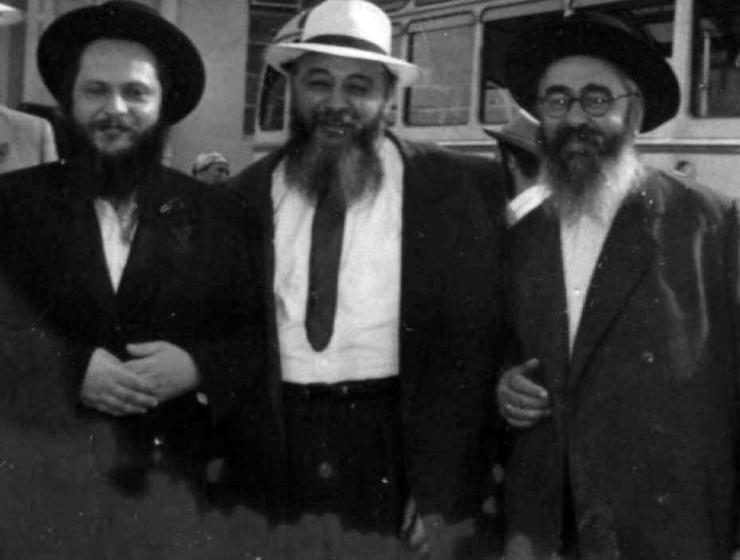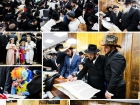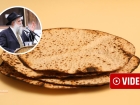The Libel of Yud-Tes Kislev 5715
From Beis Moshiach Magazine: A guest attended the central Yud-Tes Kislev Farbrengen of 5715 in Kfar Chabad and afterward wrote a letter replete with hatred and lies against the Chabad movement. This letter was given to the Rebbe who made inquiries about the truth of the matter and then responded sharply and in detail to all the allegations • Presented for Yud-Tes Kislev, the Chag HaGeula and Rosh Hashana of Chassidus • Full Article
By Nachshon Peretz, Beis Moshiach Magazine
The Rebbe wrote a sharp letter, unusual in its content, style and form, following the Yud-Tes Kislev farbrengen in Kfar Chabad. It was a farbrengen attended by thousands, led by Chabad rabbanim and various leading lights, politicians and others.
Parts of this letter appear in the Igros Kodesh and other parts are quoted elsewhere, but the letter was never printed in its entirety due to the sensitivity of the matter.
However, the big question is, why did the Rebbe respond so sharply? What is the story behind that letter?
UNINVITED GUEST
This is how the Yiddish writer, Moshe Zimmerman, described Yud-Tes Kislev 5715 in Kfar Chabad:
“Buses and cars packed with people from Yerushalayim, Tel Aviv, Haifa, Petach Tikva, etc. attended the Chabad celebration. A village Beis Medrash, gloomy yet aglow. Crowded with G-d fearing Jews, insiders, men of stature. Armored with glowing countenances, weighted entirely by dense beards and wise aphorisms. Alongside them, admirers, men of letters and ideas, thirsting for roots, yearning for a lost spiritual connection. Their numbers include members of Mapai and Mizrachi. Each of them possessors of memories of Chassidic experiences from the homes of their fathers.
“A song rises into the night, deepening, broadening, a complex song replete with ideas and debates, yearnings and consolation. A tune without words – it has no words and needs no words. The sound of deep faint basses seems to rise up as if from a well, with the tenors climbing ever higher, and all together the stream of voices grows stronger and higher, and pours forth over the twilit fields of Kfar Chabad.”
This poetic description was not published in Chabad media or even in religious media but in Davar, on Friday, 22 Kislev 5715.



Mr. Efraim Katzir [Labor party politician] and Mr. Zalman Shazar [former president of Israel] with R’ Shlomo Meidanchik and mashpia, R’ Mendel Futerfas, at a Yud-Tes Kislev farbrengen.
Indeed, many elected leaders along with leading national figures the likes of Zalman Shazar, Moshe Aram, Bentzion Dinur, Uri Tzvi Greenberg and others, attended the Yud-Tes Kislev farbrengens in Kfar Chabad over the years.
The style of the farbrengen was pleasing to the journalist who wrote for Davar but not for someone consumed by hatred and jealousy of Chabad like the writer for Digleinu who besmirched Chabad time after time. He himself attended the Yud-Tes Kislev farbrengen in 5715, despite being a Misnaged who wrote vituperative articles against Chabad and against the Rebbeim.
The uninvited guest who attended the farbrengen saw the Knesset members and the public figures drinking l’chaim, singing Chassidic tunes, and some of them even spoke about Chabad and the Chag HaGeula. The latter were welcomed to the farbrengen with the respect accorded those who helped build Chabad, and this was displeasing to the Misnaged. He knew that he couldn’t write lies in Digleinu since denials by Chabad Chassidim would show that he was a liar, so he sent a sharp letter, full of lies that were the product of his imagination, to Rabbi Uriel Zimmer, a writer and thinker who had previously written for Digleinu.
R’ Zimmer who was an active player in Chareidi activism and journalism in Eretz Yisrael, had become close to Chabad. He left for the US where he became a Chassid, mekushar and mekurav of the Rebbe. R’ Uriel was a brilliant man and many of his questions and doubts were referred to the Rebbe who responded with answers that clarified Chabad’s approach. R’ Uriel took the opportunity to send to the Rebbe some points from the libelous letter that he received and asked the Rebbe for answers.
SLANDER
What was written in that slanderous letter?
The content of the letter was kept secret because of the sensitive things written therein, including quotes from senior individuals, but after the Rebbe’s response, which you will soon see, a copy of the letter was received by a number of distinguished Chassidim in Eretz Yisrael and certain parts are publicized here for the first time.
At first, the writer explains that he did not want to address the Rebbe directly and then he launches into his diatribe:
“Last Yud-Tes Kislev, I had the unfortunate idea of traveling to the celebration in Safraya [Kfar Chabad] and I took my son with me. The humiliation of… pressed upon me and I did not know how I could bear the shame before my son. At the head of the table sat the Chassidim the ‘tmimim’ Shazar, Keseh, Bar Yehuda and Aram [all leftist Knesset members at the time].”
At this point the writer was aided by the “wisdom of face reading,” which he had apparently learned: “The shul itself swarmed with wanderer guests whose lusts and serious sins left their mark on their coarse, materialistic faces.”
The writer goes on to say that men and women mingled and he also claimed that the main speakers were not the leading mashpiim but Shazar and Yona Keseh: “I saw there the ‘ohr pnimi,’ namely the simple, innocent Chabad Chassidim who celebrated with mashke and inner song and music, and I saw the ‘ohr makif,’ the heads of Mapai whose speeches were the only spiritual content at that gathering.”
The writer defended himself from the outset against attacks upon the party he belonged to, Agudas Yisrael, and responded to the usual complaints of that time, like the reading of Ben Gurion’s letter at the Agudah convention. The writer immediately responds that the one who read it was punished and the Gerrer Chassidim, to whom the reader belonged, were forbidden to enter the shul.
In order to exaggerate his complaints, he quotes various people, one of whom said he would not be shocked if the following year the speaker in Safraya would be one of the missionaries whose parents had once upon a time belonged to Chabad.
He even quoted one of the distinguished rabbanim in Eretz Yisrael as though he said that the terrible tragedy, in which a bachur from Safraya (Yisroel Dubroskin) was killed by terrorists, happened because of the chillul Hashem caused by the Yud-Tes Kislev farbrengen!
He concluded his letter with complaints about Chabad not joining Chinuch Atzmai and ended with, “The fear for the path this movement is going on is justified and you [R’ Zimmer], the big warrior for Chareidi independence and its self-assured dignity, what do you have to say about all this?”
CLARIFICATION
R’ Uriel Zimmer sent the letter to the Rebbe as a result of which a series of clarifications ensued. The Rebbe sent letters to a number of distinguished Chassidim who had attended that farbrengen and had even been involved in organizing it, and he asked for a detailed report about the farbrengen. At a certain point, he even asked for recordings of the speeches. The Chassidim did not realize that this was an urgent request and the responses trickled in to the Rebbe. The Rebbe once again demanded full reports, recordings, etc. Among those asked to give a report was Agudas Chassidei Chabad, the vaad of Kfar Chabad, and R’ Avrohom Pariz.
Here is the Rebbe’s request of R’ Avrohom Pariz:
“Although I have written to some of Anash to inform me in detail about the farbrengen in Kfar Chabad and I am doubling my request to you too, since in your letter you write very briefly. The main thing, if possible, is to send the speeches, since when I am asked about them I do not know whether there is any basis or not, and it is clear that in such matters lashon hara is not an issue since it is for a purpose.”
The Rebbe also expressed his opinion about the reliability of the complaints in the slanderous letter:
“Especially when I suspect that those who come with complaints, their questions are based on jealousy and not on yiras shomayim and the like. Still, I would like to see the wording of the above, of course.”
The content of the speeches as well as a detailed report took time in arriving and therefore the Rebbe did not wait any longer. He sent a letter to R’ Zimmer with particularly sharp answers. We will now explain those parts connected to the Yud-Tes Kislev farbrengen.
First, the Rebbe expresses his reservations regarding the claims of the defamer and says he does not know what is true and what is made up. Still, even assuming that all the details are correct, the situation could be looked at from two possible perspectives. One perspective is that the hanhala of Kfar Chabad is interested in the mingling of men and women, and that the main speakers be representatives of a certain party. The Rebbe explains that a discussion with someone who thinks this is really the situation is pointless, as our Sages say, “any encounter with them is bad.”
The other option would be to say that the hanhala of Kfar Chabad understands what mingling is about, but for certain reasons they did not send the women away from the celebration and they also saw to it that so-and-so and so-and-so would speak in praise of Chassidus [although not necessarily the representatives of a certain party].
Regarding the complaint that it was all done for money, i.e. budgetary bequests from elected officials, the Rebbe responds that to the best of his knowledge since the celebration the people of the Kfar did not receive any additional money, but with the help of those participants [elected public officials], spiritual benefits did accrue (not necessarily for the residents of the Kfar)! Furthermore: Thanks to those who attended the Yud-Tes Kislev celebration, over the past year, hundreds of Jewish boys and girls learned Toras Hashem in its pure form.
In general, added the Rebbe, the Jews of Poland, Galicia, and Russia were always in touch with Jews like these and even gave them honors, “and used their influence and efforts to cancel undesirable decrees and laws, to make things easier in the spiritual matters of the Jewish people and even material things regarding the livelihood of Jews.”
The Rebbe goes on to mention the events that occurred at the Knessia Gedola of Agudas Yisrael that took place half a year earlier but in the letter the Rebbe does not specify what he means.
The Rebbe even mentions “forgotten things”: Surely you know that there was a coalition in the government with the consent of etc. [referring to the gedolim and Admorim of Agudas Yisrael], and you know how much so-and-so of his party tried to get a ministerial position so as to also be responsible for laws and orders etc. [the reference is to R’ Itche Meir Levin who served as Welfare Minister under the aegis of Agudas Yisrael for several years, thus being a partner to whatever the government did in the early days of the State].



President Shazar at a Farbrengen in Kfar Chabad
The Rebbe expresses surprise: During the days of the coalition did the writer of the letter express himself against the minister from Agudas Yisrael who sat with ministers of Mapai and Mapam?!
In the besmirching letter it quoted a young man who said about certain people who attended the Chabad event that they are worshipers of avoda zara b’shituf. In general, the besmirching letter and the letter of the young man cited therein are full of the most biting language and the Rebbe writes:
“I hold in disdain all those who describe an entire movement which numbers tens of thousands of Chassidim, the likes of whom the describers do not reach their ankles, not in mesirus nefesh and not in yiras shomayim and not in genuine tznius […] and shemiras ha’lashon – describing them with descriptions in that letter, and their students and disciples do not recoil from saying about a Jew that he worships avoda zara b’shituf […]
In continuation from the above, following the Yud-Tes Kislev celebration, “despite everything” not one person was missing from even one of the shiurim learned in the Kfar, on the contrary. The number of those who immerse in a mikva before davening even on weekdays did not diminish, on the contrary, etc. etc.
This is how the Rebbe explained to R’ Zimmer the importance of a relationship with elected officials and inviting them to a Chag HaGeula farbrengen.
THE PARTISAN’S LETTER
When I worked on the book HaPartisan, about R’ Zushe Wilyamowsky, I got to see some confidential material on this subject, since he was quoted in the defaming letter, as a result of which the Rebbe wrote to him. R’ Zushe responded in a letter that he never said such things. In the end, even the Misnaged writer said he had written those things in error in the name of R’ Zushe. This bothered R’ Zushe which is why he wrote a letter to R’ Zimmer. Here are some quotes from that letter:
“The sincere of heart see that the activities of the Rebbe are holy of holies (and those who do not want to see because of personal agendas) surely the day will come and those among them who will be meritorious will know that Moshe is true and his Torah is true. Rather, my purpose with this letter is to deny the defamation of the holy community Kfar Chabad.
“And I have no doubt that the defamer does not come to the ankles of the least of the residents of the Kfar, especially when they are a congregation of Chassidim who are currently the spirit of resurrection in disseminating Torah with fear of heaven and strengthening Judaism in nearly all countries of the world, so whence does this chutzpa come from? But our job is not to enter into debates with the evil of someone and our role is just to illuminate and the darkness will come to an end by itself as in the saying of the Tzemach Tzedek, ‘we are day workers.’”As for inviting people who were not religious to the farbrengens in Kfar Chabad, R’ Zushe explained that by doing so they prevented demonstrations and many protests whose effectiveness were dubious at best. To all residents of the Kfar it was obvious that inviting these individuals was done for the sake of holiness and not for business, especially when the guests urged everyone to a yearning for authentic Judaism.



From left to right: R’ Uriel Zimmer, R’ Pinye Altheus, R’ Yaakov Yosef Raskin
As for mingling of men and women, R’ Zushe said this was not correct for the women gathered in a special area as organized by the women of the Kfar.
To this very day, elected officials and prominent people close to Chabad continue to go to Kfar Chabad for the Yud-Tes Kislev farbrengen.
MISNAGDIM AND CHASSIDIM IN CHEVRON
Misnagdim at a farbrengen?
The following is an earlier account by a Litvishe writer who describes a Yud-Tes Kislev farbrengen where Misnagdim were present. Here is a fascinating news item from Chevron from the year 5688/1927. At that time, the Chabad community had dwindled due to Chassidim having left during World War I. The Yud-Tes Kislev farbrengen was attended by Lubavitcher Chassidim along with Chassidim of grandchildren of the Tzemach Tzedek as well as Misnagdim who lived in Chevron.
This is a news item from Doar HaYom from 24 Kislev 5688:
Chevron. From our special correspondent. Wherever Chabad Chassidim are to be found, they celebrate Yud-Tes Kislev when the Baal HaTanya was freed from jail, and they make a festive meal to commemorate the event. This custom took place in Chevron too throughout the generations with great pomp, since the city was settled primarily by Chabad Chassidim, descendants of the Mitteler Rebbe. The festive meal would last all day and night, wines were ordered from the best Chevron grapes that were prepared by elders and men of stature for the sake of the Kislev feast, and they were entertained by words of Chassidus, original Chabad niggunim… and dancing.
However, in recent years, as the old yishuv shrinks, many have died and many moved elsewhere in the country and abroad, and were replaced by new settlers, nearly all Litvaks, the glory of the Yud-Tes Kislev celebration in Chevron departed. The “grandchildren” [those whose grandparents were Chabad] do gather every year and have a seudas mitzva and are also accompanied by many “Misnagdim,” residents of Chevron. Words of Chassidus and niggunim are still heard, but it is all done with coolness and haste and after too much drinking there sometimes starts the barbs and arguments. Especially between Chassidim who came from abroad, students of the Rebbeim of Lubavitch descended of the lineage of the Tzemach Tzedek, and those born in Chevron who have their own great lineage as grandchildren of the grandmother Menucha Rochel, founder [SZB – there were Chabad settlers before her] of the Ashkenazi yishuv in Chevron who was also a granddaughter of the Baal HaTanya, and who are not that bound to the current Lubavitcher Rebbe [Rayatz]. Ultimately, the participants conciliate and all ill will is uprooted from the heart.
*
The magazine can be obtained in stores around Crown Heights. To purchase a subscription, please go to: bmoshiach.org
138
Join ChabadInfo's News Roundup and alerts for the HOTTEST Chabad news and updates!












































